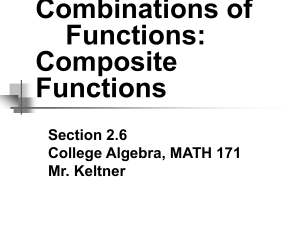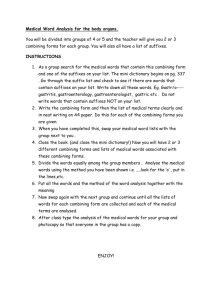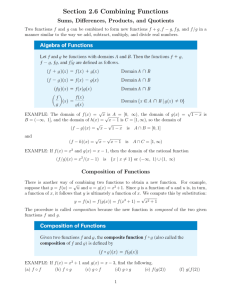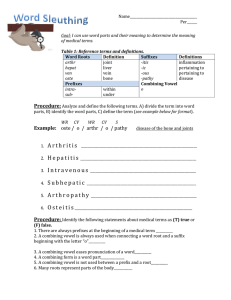Introduction to Computers and Programming Terminology
advertisement
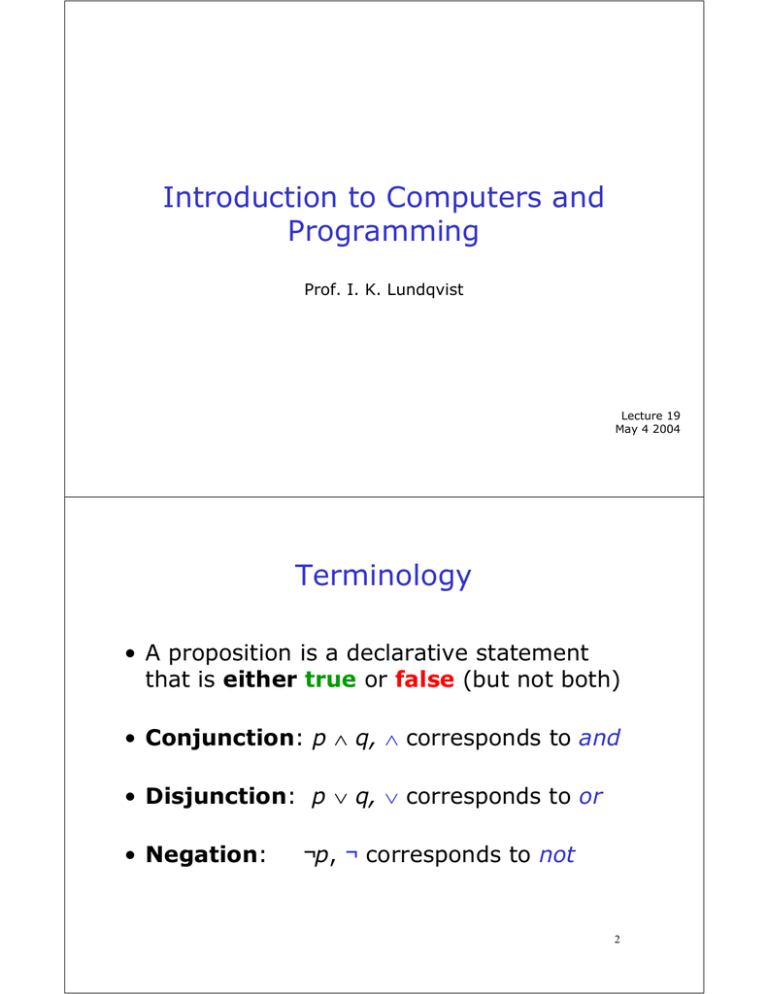
Introduction to Computers and
Programming
Prof. I. K. Lundqvist
Lecture 19
May 4 2004
Terminology
• A proposition is a declarative statement
that is either true or false (but not both)
• Conjunction: p ∧ q, ∧ corresponds to and
• Disjunction: p ∨ q, ∨ corresponds to or
• Negation:
¬p, ¬ corresponds to not
2
CQ 1
P = Everyone loves ice cream; Q = X loves ice cream
P is a proposition, Q is a proposition
1. True, False
2. True, True
3. False, False
4. I don’t know
3
Implication
• Implication: p → q, → corresponds to implies
“if it rains, then it is cloudy”
p = it rains
q = it is cloudy
p→q
P Q P
PVQ
0 0 1
1
0 1 1
1
1 0 0
0
1 1 0
1
4
Rule of Inference
p
∴p∨q
p∧q
∴p
p, q
∴p∧q
p, p → q
∴q
¬q, p → q
∴ ¬p
p → q, q → r
∴p→r
p ∨ q, ¬p
∴q
p ∨ q, ¬p ∨ r
∴q∨r
Tautology
p → (p ∨ q)
Name
Addition
(p ∧ q) → p
Simplification
(p ∧ q) → p ∧ q
Conjunction
(p ∧ (p → q)) → q
Modus Ponens
(¬q ∧ (p → q)) → ¬p Modus Tollens
((p → q) ∧ (q → r))
→ (p → r)
((p ∨ q) ∧ ¬p) → q
(p ∨ q) ∧ (¬p ∨ r)
→q∨r
Hypothetical
Syllogism
Disjunctive
Syllogism
Resolution
5
Ex: Consider these statements “If I buy something, then I go to the
store.” and “If I go to the store, then I drive my car.” If these two
statements are true, then by hypothetical syllogism we can conclude
that “If I buy something, then I drive my car.”
Ex: Consider the statements “It is raining today or it is snowing
today.” and “It is not snowing today or it is windy today.” If we
know both of these statements are true then what can we conclude?
By the rule of resolution, we know that “It is raining today or it is
windy today.”
6
Ex:
Show that
[(¬p ∧ q) ∧ (r → p) ∧ (¬r → s) ∧ (s → t)] → t
is a true statement.
Proof:
We assume the hypotheses (¬p ∧ q), (r → p), (¬r → s), and (s → t)
1. By (¬p ∧ q) we know ¬p
[simplification]
2. By (r → p) we know ¬p → ¬r
[contrapositive]
3. By 2 and (¬r → s) we know (¬p → s)
[hypothetical syllogism]
4. By 3 and (s → t) we know (¬p → t)
[hypothetical syllogism]
5. By 1 and 4 we know t
[modus ponens]
7
Ex: A detective has interviewed four witnesses to a crime. From
the stories of the witnesses the detective has concluded that if
• the butler is telling the truth, then so is the cook;
• the cook and the gardener can not both be telling the truth;
• the gardener and the handyman are not both lying;
• and if the handyman is telling the truth then the cook is lying.
For each of the four witnesses, can the detective determine whether
that person is telling the truth or lying?
(1) b → c
(2) ¬(c ∧ g)
or
¬c ∨ ¬g
(3) ¬(¬g ∧ ¬h)
or
g∨h
(4) h → ¬c
8
(1) b → c
or
¬b ∨ c
(2) ¬(c ∧ g)
or
¬c ∨ ¬g
(3) ¬(¬g ∧ ¬h)
or
g∨h
(4) h → ¬c
or
¬h ∨ ¬c
By combining (1) and (2) we get
(5) ¬b ∨ ¬g
By combining (1) and (4) we get
(6) ¬b ∨ ¬h
By combining (2) and (3) we get
(7) ¬c ∨ h
By combining (3) and (4) we get
(8)
g ∨ ¬c
9
(1) ¬b ∨ c
(5) ¬b ∨ ¬g
(2) ¬c ∨ ¬g
(6) ¬b ∨ ¬h
(3) g ∨ h
(7) ¬c ∨ h
(4) ¬h ∨ ¬c
(8) g ∨ ¬c
By combining (1) and (7) we get
(9) ¬b ∨ h
By combining (1) and (8) we get
(10) ¬b ∨ g
By combining (2) and (8) we get
(11) ¬c ∨ ¬c ≡ ¬c
By combining (3) and (5) we get
(9) ¬b ∨ h
By combining (3) and (6) we get
(10) ¬b ∨ g
By combining (4) and (7) we get
(11) ¬c ∨ ¬c ≡ ¬c
By combining (5) and (8) we get
(12) ¬b ∨ ¬c
By combining (6) and (7) we get
(12) ¬b ∨ ¬c
10
(1) ¬b ∨ c
(5) ¬b ∨ ¬g
(9) ¬b ∨ h
(2) ¬c ∨ ¬g
(6) ¬b ∨ ¬h
(10) ¬b ∨ g
(3) g ∨ h
(7) ¬c ∨ h
(11) ¬c
(4) ¬h ∨ ¬c
(8) g ∨ ¬c
(12) ¬b ∨ ¬c
By combining (9) and (4) we get
(12) ¬b ∨ ¬c
By combining (9) and (6) we get
(13) ¬b ∨ ¬b ≡ ¬b
By combining (10) and (2) we get
(12) ¬b ∨ ¬c
By combining (10) and (5) we get
(13) ¬b ∨ ¬b ≡ ¬b
By combining (11) and (1) we get
(13) ¬b
By combining (12) and (1) we get
(13) ¬b ∨ ¬b ≡ ¬b
We can see that (13) won’t combine with anything so we’re done.
We have come to the same conclusions as before ¬b and ¬c. 11
Predicate Logic
• Predicate logic: composed of atomic
sentences which are made up of:
– Constants, or objects, such as “Butterflies”
– Variables, such as X
– Predicate such as “eats”, “likes”, “bigger than”
• It also uses quantifiers which allow
general statements such as All butterflies
are colorful, or There are some elephants
that like mangoes
12
Universal Quantifiers
Let P(x) be a predicate on some universe of discourse.
The universal quantifier of P(x) is the proposition:
“P(x) is true for all x in the universe of discourse”
Formally: ∀x P(x) is read as “for all x, P(x)”
• ∀x P(x) is TRUE if P(x) is true for every single x
• ∀x P(x) is FALSE if there is an x for which P(x) is false
13
Finite Universes
( ∀x Work_Hard(x) →
get_an_A(x) )
In the special case that the universe of discourse,
U = {x1, x2, x3, …, xn}
∀x P(x)
P(x1) ∧ P(x2) ∧ … ∧ P(xn)
14
Existential Quantifiers
Let P(x) be a predicate on some universe of discourse U.
The existential quantifier of P(x) is the proposition:
“P(x) is true if it is true for at least one x in the universe of
discourse”
Formally, ∃x P(x): is read as “for some x, P(x)”
• ∃x P(x) is FALSE if P(x) is false for every single x
• ∃x P(x) is TRUE if there is an x for which P(x) is true
15
Finite Universes
∃x x is awake
In the special case that the universe of
discourse, U, is finite, (U = {x1, x2, x3,
…, xn})
∃x P(x)
P(x1) ∨ P(x2) ∨ … ∨ P(xn)
16
Lions and Coffee
Given U = all creatures:
– L(x) = “x is a lion.”
– F(x) = “x is fierce.”
– C(x) = “x drinks coffee.”
All lions are fierce.
∀x (L(x) → F(x))
Some lions don’t drink coffee.
∃x (L(x) ∧ ¬C(x))
Some fierce creatures don’t drink coffee.
∃x (F(x) ∧ ¬C(x))
17
Butterflies and Nectar
B(x) = “x is a butterfly.”
L(x) = “x is a large butterfly.”
N(x) = “x lives on nectar.”
R(x) = “x is richly covered.”
All butterflies are richly colored.
∀x (B(x) → R(x))
No large butterflies live on nectar.
¬∃x (L(x) ∧ N(x))
Insects that do not live on nectar are dully colored
18
CQ 2
Insects that do not live on nectar are dully colored
1. ∀x (¬N(x) → ¬R(x))
2. ∀x (N(x) → R(x))
3. ∀x (¬N(x) → R(x))
4. Don’t know
19
Negating Quantifiers
• ¬∀x P(x) is the same as ∃x ¬P(x)
• ¬∃x P(x) is the same as ∀x ¬P(x)
Rule of Thumb: to negate a quantifier,
move negation to the right, changing
quantifiers as you go
20
Quantifier Negation
No large insects live on nectar
¬∃x (L(x) ∧ N(x)) = ∀x ¬(L(x) ∧ N(x))
Negation rule
= ∀x (¬L(x) ∨ ¬N(x)) DeMorgan’s
= ∀x (L(x) → ¬N(x))
Subst for →
21
Proofs
• A theorem is a statement that can be
shown to be true
• A proof is the means of doing so
Axioms, postulates, hypotheses, previously proven theorems
Rules of Inference
Proof
22

